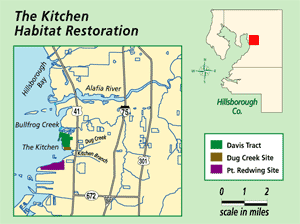Award-Winning Restoration

A place where people used to illegally dump everything from scrap metal to household waste is the site of an award-winning restoration project. The joint project between SWIM, Hillsborough County’s resource management section and the District’s Davis Tract restoration project received the Hillsborough County Planning Commission’s top environmental award, the Award of Merit, 2002.
The 60-acre former landfill is part of the 354-acre Davis Tract, which is part of a bigger restoration project being completed in Tampa Bay. The whole restoration project encompasses parts of three tracts of land, the Davis Tract, Dug Creek and Port Redwing. Together this region of the Bay is known as the “Kitchen.” The area was dubbed the Kitchen because fish, crabs, shellfish and birds were abundant throughout the Kitchen’s variety of habitats.
Hillsborough County’s Environmental Lands Acquisition and Protection Program purchased the Davis Tract in 1997 with the intent to restore the property. But before construction could begin at the site of the former landfill, District and county staff had to do a lot of work.
“Tons and tons of illegally dumped debris that had been deposited there for over 30 years had to be removed,” said Brandt Henningsen, a Surface Water Improvement and Management (SWIM) program project manager for the District.
Hillsborough County resource management staff supervised and worked with teenagers from the Youth Environmental Services (YES) program to remove car parts, tires, old furniture, old fencing, bags of garbage and even an abandoned motorcycle.
“Removal took about 6 months because they went out there whenever they had a work crew available,” said Henningsen. “The crews would fill up a garbage truck, dump truck, or pick-up…whatever they had available at the time.”
After that, District staff went in and began removing the non-native species that invaded the area. A HydroAxe was used to remove about 80 percent of the nuisance vegetation. A HydroAxe is a machine that can simultaneously remove plants and turn them into mulch. The rest of the work had to be done by hand or by using a bulldozer.
Several steps were taken to make sure the nonnative plants would not immediately grow back. First, the plants were removed when they were not germinating. The nonnative plants were turned into mulch and sterilized by baking it in the sun. If any seeds or berries were in the mulch, they were basically “cooked.” Besides using the nonnative plants as mulch, tens of thousands more cubic yards of recycled yard waste was also used as mulch. The mulch was donated and spread free of charge by Consolidated Resource Recovery, Inc.
After that, an 18-inch covering of mulch was spread over the entire site. Using mulch increases plant survival, reduces the growth of non-native species and reduces maintenance needs for 18 to 24 months.
Construction at the site involved transforming a borrow pit, roadway and rim ditches to viable, productive open water and marsh habitats.
“We were able to fill in the borrow pit, reshape it and turn it into a nice, productive intertidal open water lagoon system,” said Henningsen.
The intertidal open water lagoon has two connections to Bullfrog Creek and another connection to a created tidal channel that circles the entire tract.
Removing spoil mounds in the area resulted in the development of tidal channels and marshes, providing open water connections to the Kitchen. The spoil mounds are made up of the leftover fill that came from when mosquito ditches were dug. District staff was able to remove most of the mounds and turn the area into productive wetlands.
Some of the fill that wasn’t used to re-fill the borrow pit was used to construct an observation mound and upland feature. The observation mound, which provides a great view of Tampa Bay, is approximately 35 to 40 feet high and is one of the higher elevations on the east side of Tampa Bay. Henningsen says the county’s park and recreation department plans to build a structure for environmental educational information on the observation mound. The restored site is designated a green space nature park to be developed and managed by Hillsborough County.
More than 400 volunteers coordinated by Tampa BAYWATCH also played a key role in the restoration process. These dedicated volunteers helped plant native plants in the salt marshes during four planting events. This spring volunteers will install oyster culch in the intertidal lagoon. Oyster culch, which is crushed oyster shell, will provide flat surfaces on which juvenile oysters can attach and grow.
Besides being home to a variety of wildlife again, the site also helps prevent some pollutants from entering Tampa Bay. The natural system has sumps and marshes that help remove some of the sediment and nutrients found in the urban stormwater runoff that enters the system. The water enters the bay cleaner after passing through the restored habitats then when it entered the system.
The Davis Tract Restoration cost approximately $300,000. Funding for the Davis Tract project was divided among state SWIM funds, the Alafia River Basin Board and the Gardinier Trust Fund, a granting program administered by Hillsborough County and the Florida Department of Environmental Protection (DEP). The project received $200,000 from the Gardinier Trust Fund.
